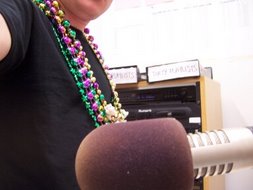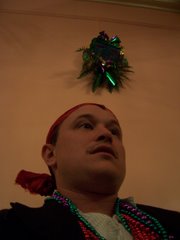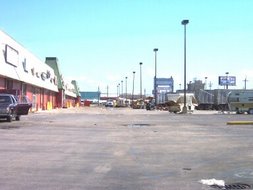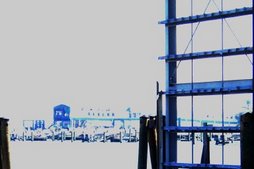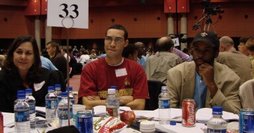
I straddle my bike in front of a cooler chest. One of two salesmen digs into the ice and water and pulls out a bottle.
“That cold enough for you?”
“I hope so. I’m gonna need it today.”
I give him $3 but he can’t open the bottle with his lighter, so his partner does it, and then scoffs at the other’s ineptitude. I thank them both and pedal slowly into the intersection of Washington and LaSalle. The block is full of people, with a large crowd at one end gathered in front of a line of cops on horses. Feathered headdresses are visible above the fray, the sky is bright, and the air is warm but dry, perfect March weather in New Orleans.
Today is Super Sunday, the traditional parading day for the Mardi Gras Indian tribes held the Sunday before St. Joseph’s Day. Back when the Indians were violent and illegal, this was the day of the year when they could come out and show their colors. Now we’re standing in one of the most violent neighborhoods in the city and the tail of the parade is beginning to move.
I ride down LaSalle to check out the spy boys, braves, and chiefs preparing. The street has a neutral ground in the middle and various pieces of costumes rest in the grass. At a break in the neutral ground, I u-turn and ride back up the street towards Washington Avenue. Lone Indians stand stone-faced in full “mask,” clusters of onlookers surrounding them.
The crowd: young men with the practiced thousand-yard stare; older guys who get in the face of the Indians, alternately trying to crack them up or boost their egos into full whoop as the maskers stay intense and serious; the wives and mothers of the Indians, who help them put on their costumes and straighten their headdresses; children in and out of costume; white hipsters young and old, cameras at the ready.
What I notice immediately (and start to record with my own camera) is the prevalence of cameras. Any immobile Indian has a phalanx of cameras around him, held in white and black hands, snapping away. Some are huge video cameras with long lenses, others just the camera phone. The Indians are such wildly vivid figures, it’s hard to stop snapping, and indeed there are dudes who walk backwards in front of the marchers as they begin to move down LaSalle.
It’s weird to watch people squint and focus so intently on capturing the exotic, like we’re all on a safari rather than in a neighborhood. I don’t know if that’s always been the case on Super Sunday, but it’s safe to say that more people own cameras these days, and have them always on-hand in phones or in handy digital models. What do we get from photographing something? What do we lose by pausing to record, rather than allowing the experience to unfold? Can you have any sort of epiphany with one eye in on a screen?
Aside from these questions, I wonder about the younger white kids like me. Are we simply voyeur witnesses to the last embers of a culture, or will we help lay the groundwork for a more equitable city, one where the Indians and their neighbors survive and prosper, every day of the year? Obviously, we have some interest; some love of this side of New Orleans, but how many of us ever walk these blocks the other 364 days of the year?
That’s what struck me over and over again today—how rare it was for any white person to be in this neighborhood. That’s an old fact, but, again, what do we do in this new landscape? What does it mean that one race simply doesn’t cross into a certain space? How does that affect all of us?
I stand with my bike in front of me as the crowd grows thick and begins to follow the last tribe and brass band. When a space opens up, I join in behind another beer salesman. He tows his cooler on a battered hand-truck, wears a gray-black-white camouflaged suit, and seems nervous, not stopping as people place orders. Instead, he’ll pull out the beers, then the customer takes over and drives the hand-truck while the beer man makes change.
It’s not a fluid operation, but it works, and I keep wondering what’s the rush. Then I hear a snort, and turn to see that the line of police horses is only 5 paces behind us. I pick up the pace, order a Budweiser. Another white dude is doing the same, and he ends up just buying my bottle for me, saying, “Happy Sunday,” so that all of us can keep moving.
LaSalle turns into Simon Bolivar and an Indian runs by whooping, feathered tomahawks slicing the air. Another group of Indians in white skull faces menaces the crowd. Down here people loll in the shade on the neutral ground, drinking and lighting blunts. I stand between some cars to watch the parade pass. A beat-up old lady comes to talk to me, and we walk together for a minute.
“Enjoying yourself today mmm, hmmm, mmm,” she says with a vacant smile. Her voice is low and she seems lost.
“Oh, yeah, it’s a fine day,” I tell her.
“Hmmmm. Since Katrina, my head still ain't right….” She says it like a question, like she’s in disbelief. “Hmmmm…..19 feet of water…..walk on water…..”
I tell her to take her time, then cross to a boarded up seafood store and lock up my bike. It’s getting hard to hold a bottle in one hand and walk the bike with the other. The parade turns onto Jackson Avenue and I let it pass me so I can buy another beer. The guys I ask aren’t selling, but they point me across the street to another pick-up truck.
When I get there, a couple stands in the bed of the truck with a full bar’s worth of liquor sitting on the roof of the cab. They have gin, whiskey, schnapps, vodka, everything. I try to order a 7 and 7, but the woman asks me to explain what that is. As I do, a cop walks u
 p.
p.“I got no problem with your operation,” he says, “but can you move it to the side a little, you’re blocking the street.”
So the truck backs up as the lady makes my 7 and 7, which turns out to be just gin and some flat seltzer water, no ice, in a small plastic cup. And as I hand up the money, it turns out she’s not a lady, but a man in some very basic drag, with long sideburns and a mustache and trucker’s cap.
“Thanks, baby,” I say.
I’ll admit, the last thing I need is gin, but I dug that operation, too. Anyway, things get a little hazy for the remainder of the day. The Indians and I move at about the same pace, so I see the same few tribes and band again and again, followed by the line of police horses. We walk in the street, the Indians vibrant and pulsating, many of the buildings windowless and weather-beaten. Chants rise up and braves dash about, regroup, strut, squat in wait.
At one point, I’m watching an Indian in all red feathers approach, and can hear only a tambourine. As he passes me, I hear a burst of sound from an un-costumed brass band; they look like one family, mother and 4 children, almost hidden behind the Indian’s headdress. Everywhere along the street, people whoop and call out, take photos and drink and smoke, take it easy in the holiday afternoon. Along with Mardi Gray Day, and maybe New Year’s Eve, this hour of walking feels as close as it can get to the pre-Katrina city I knew.
The funny thing is, it’s only in the extraordinary moments that things feel normal, like nothing happened.
On one stretch of Martin Luther King Drive, I stop to take in a very strange sight on the neutral ground. Someone has tricked out a convertible Mercedes coupe in ridiculous fashion. Not only is the light gray interior done up in what appears to be fake alligator, including the cup holder, but the gearshift is a fake pistol.
Yep, what looks to be a glock is mounted nose-down on the console. The doors of the coupe are vertical, ala the DeLorean, and in a true stroke of genius, three Chucky dolls stand in the back seat. The top is down and kids take turns jumping in the front seat for pict
 ures. I start taking close-range self-portraits in various ill poses, arms crossed or cup of gin held up to my lips. I guess I’m causing a scene, because a few white kids come up and remark to me on how crazy the car is, alright.
ures. I start taking close-range self-portraits in various ill poses, arms crossed or cup of gin held up to my lips. I guess I’m causing a scene, because a few white kids come up and remark to me on how crazy the car is, alright.“It’s the dumbest car ever,” I tell one.
“I love it!” he says. I move on.
At the corner of South Claiborne and MLK, a very ingenious person opened a large convenience store and gas station, with hip-hop clothing for sale on one side of the building. Most days, this is where day laborers, Latino and black, gather to wait for work. Today, the parking lot is full of speed bikes and their riders. Maybe 60 bikes are out there, taking up one whole corner of the parking lot.
I stand under the shade of the island and take them all in, then give Kim a call and give her my coordinates. I walk into the store to get more beer and water, and she meets me in there a few minutes later. Once again, I’m sure glad to see my woman. She can see I’m a little loopy and hands me the water, takes the beer.
We continue down MLK. The parade is thinning out as we go, the space between groups of Indians growing. Occasionally, we sit down and watch it pass, then get up and catch the tail. At one point we’re right next to the horses when we notice two white chicks wearing identical fluorescent green hats and armbands. The armbands read “ACLU,” and the girls carry clipboards.
“Say, what are y’all up to?” I ask.
“We’re here to monitor the police,” one tells me.
Apparently they accompany the cops at many parades, noting when they get out of line.
“What kind of stuff do you write down?”
“Well, like this right here.” She points to another line of horse cops who cross in front of a group of parade goers, almost running them
 over. I wish them luck and move on.
over. I wish them luck and move on.When we get to Jackson Avenue, I see a group of cops handcuffing a guy. It’s the beer man in the camouflage from before. A burned nub of blunt sits on his cooler. He isn’t resisting. That man probably made 700 bucks today, all right in front of that line of horse cops. If he hit that blunt, it must’ve been more than once. But now that we’re near the end of the parade, he’s under arrest. Seems like a convenient time for someone to pick up an easy $700, right?
“Fuck,” I say. I walk up fast and slip my card in his pocket, which is a stupid, futile thing to do. Kim gets the attention of the ACLU. We stand on the corner and swear. What a bunch of bullshit.
Across the street, a group of Indians in pink and brown feathers attempts to join the parade. A meeting of sorts ensues between what looks to be several chiefs of different tribes. There’s some posturing, the ritual plays out, and the new tribe joins the march.
If this was the beginning of the 20th century, this is the kind of run-in that could result in violence. Today, the argument is probably about the proper show of respect and order. Indians are serious about this and the disputes they have concern precedence and honoring past “maskers” and their teachings. The fierce defense of heritage might just save this whole place, and that’s why I follow the Indians. Of course, this stops the parade and causes the police cruisers to honk.
We reach Marcus Garvey Park at Washington and S. Claiborne and push our way through one small gate in the fence. Inside, the whole parade—Indians and followers—fills in the lawn, drinking, inspecting costumes, lounging in the sun. On a stage at one edge of the park, a speaker informs us of a march on City Hall. I think about Ed Blakely, how he might have the right idea but how he should be here today if he’s really going to solve things.
After awhile, Kim and I agree we’re hungry and ought to be getting out of there. It takes long waits at two different, over-matched food trucks, but I get us an order of some pretty damn good fries. We walk down Claiborne to Jackson and head towards the river. In the middle of Jackson, a single Indian in royal blue and orange feathers marches in the early dusk.
“He’s like the King of Jackson Avenue,” I say.
A car with its flashers on follows him slowly and soon a line of cars trails lazily down the avenue behind them. Kim and I are talking, not paying attention, then we see the line of traffic has stopped. Some dude with short dreads and a bright orange shirt has stopped his Saturn behind the Indian, gotten out of the car, and challenged the driver of the car guarding the Indian. The driver keeps telling the dude to chill as the Indian looks on.
“Are you ready? Are you ready, bitch?” the dude in orange asks, fists now held up. The two of them are 10 feet from us. On the corner behind us, a group of men and children watches as the fight starts. Some punches are thrown, they lock up in a bear hug, the Indian’s driver down lower around the dude’s torso. Eventually they work their way to a telephone pole where the Indian comes up behind the dude and tries to pry him off.
“We oughta steal his car,” I joke, nodding at the idling Saturn.
The people on the corner continue to tell the dude to step away, as it’s now a stalemate. Kim and I start to walk away, but I turn once more to look back and see the dude’s head banging over and over against a parked car. The Indian’s driver really whips the dude’s ass, leaving him lying on the curb, struggling to get up. The Indian sits down on the hood of his friend’s car and they pull away, charioteer and chariot, disappearing down Jackson Avenue.
On the next block, a group of old ladies sits on a porch. They ask us what happened and we tell them. We all shake our heads.
“He should’ve known not to mess with that Indian,” I say to general assent.
“He does now,” Kim says.




